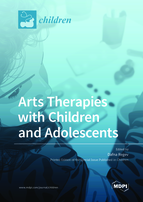Arts Therapies with Children and Adolescents
A special issue of Children (ISSN 2227-9067). This special issue belongs to the section "Global and Public Health".
Deadline for manuscript submissions: closed (15 August 2022) | Viewed by 62549
Special Issue Editor
Interests: art therapy in the education system; parent-child art psychotherapy; the effectiveness of art therapy; theoretical approaches to art therapy
Special Issue Information
Dear Colleagues,
Art therapy is a form of psychotherapy that uses artistic media, the creative process, and artwork as its primary forms of communication. Art therapies cover six areas of specialization: visual arts, music, dance and movement, drama, psychodrama, and bibliotherapy. A number of studies and reviews have demonstrated its effectiveness for both adult populations (e.g., Regev and Cohen-Yatziv, 2018) and children as well as adolescents (e.g., Cohen-Yatziv and Regev, 2019). Academic writing and research, both of which have evolved extensively in recent decades, have highlighted the considerable significance of art therapies, especially for young people.
This Special Issue, “Art Therapies with Children and Adolescents”, is dedicated to presenting research and clinical writing on the implementation of art therapies in a variety of settings, including hospitals, the education system, and mental health clinics, as well as others. Original research, including reviews and in-depth case descriptions, will be considered for publication.
The graphic abstract of this Special Issue is “Inbal Regev made the drawing on a photograph taken by Shir Harpazi”.
I look forward to receiving your contributions.
Sincerely,
Dr. Dafna Regev
Guest Editor
Manuscript Submission Information
Manuscripts should be submitted online at www.mdpi.com by registering and logging in to this website. Once you are registered, click here to go to the submission form. Manuscripts can be submitted until the deadline. All submissions that pass pre-check are peer-reviewed. Accepted papers will be published continuously in the journal (as soon as accepted) and will be listed together on the special issue website. Research articles, review articles as well as short communications are invited. For planned papers, a title and short abstract (about 100 words) can be sent to the Editorial Office for announcement on this website.
Submitted manuscripts should not have been published previously, nor be under consideration for publication elsewhere (except conference proceedings papers). All manuscripts are thoroughly refereed through a single-blind peer-review process. A guide for authors and other relevant information for submission of manuscripts is available on the Instructions for Authors page. Children is an international peer-reviewed open access monthly journal published by MDPI.
Please visit the Instructions for Authors page before submitting a manuscript. The Article Processing Charge (APC) for publication in this open access journal is 2400 CHF (Swiss Francs). Submitted papers should be well formatted and use good English. Authors may use MDPI's English editing service prior to publication or during author revisions.
Keywords
- art therapy
- music therapy
- drama therapy
- psychodrama
- dance and movement therapy
- bibliotherapy
- children
- adolescents
- arts-based assessment







